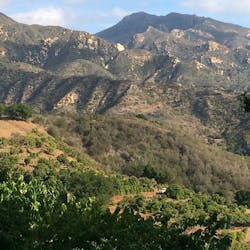You no longer need to travel to Brazil, Colombia, Indonesia or Vietnam to witness how coffee is grown and produced. One farmer found that Southern California’s unique ecosystem and ideal growing conditions made it a quintessential place to grow coffee. In 2002, Jay Ruskey planted the first coffee trees on his farm, Good Land Organics, located in the hills of Goleta, CA. Now, in 2014, Ruskey is harvesting several coffee varieties from his farm, making him the first commercial coffee grower in the continental U.S.
Climate influences
In Hawaii, the only U.S. state previously known to produce coffee, farmers grow their crop at elevations of 2,000 to 3,000 feet, while in places like Central America, coffee grows between 4,000 to 6,000 feet. In the foothills of Santa Barbara, CA, however, Ruskey grows his crop at an elevation of 650 feet. But that doesn’t negatively affect the taste of his coffee. “What we lack in altitude, we make up in latitude,” said Ruskey. Ruskey’s coffee variety Caturra received a cupping score of 91 this month from Coffee Review and its Geisha received a cupping score of 88.5 earlier this year from a registered Q-grader. According to the Specialty Coffee Association of America (SCAA) guidelines, a score of 85 to 89.99 is deemed “excellent” while a score of 90 and above is “outstanding.” A score that receives an 80 or above is considered “specialty.”
The southern climate gives the California-grown coffee tree the ability to thrive. It brings with it coastal temperatures: frost-free winters and mild summers, making it the perfect combination for coffee trees to grow. Additionally, the unique California ecosystem includes rich clay loam soil and climate patterns that contribute to the company’s ability to grow coffee beans and other specialty sub-tropical fruits other locations around the area cannot.
Where it all began
Ruskey, who farms a variety of fruits, had been partnering with Mark Gaskell, a small crop specialist from the University California Cooperative Extension, on several projects for a few years when one day in the early 2000s Gaskell approached Ruskey about growing coffee on his farm. “He showed up and said, “Plant these” and he handed me coffee trees,” said Ruskey with a laugh. “He also bought me my first de-pulper.” Over the last decade Ruskey has had to learn how to become a coffee farmer. Since the beginning he has been using a Central American growing process where he cultivates his avocados and coffee on the same tree. “The avocados protect the cherries from wind,” he said. “But it’s too early to tell whether or not they are affecting the taste of the cherry.” Unlike Central and South America coffee farmers, however, Ruskey uses fertigation to irrigate his coffee crop. “Draught has been the toughest threat I’ve had thus far,” he said.
Not the only one
Ruskey, although the first and largest California coffee grower, is now not the only one. “Other growers are using the coffee plants that I grow and sell to them,” said Ruskey. He is also open to having people study his coffee. “There are many advances in disease resistance with other crops,” he said. “So why not coffee?” For now, however, Ruskey and his staff will continue to harvest the beans and sell them at local farmers’ markets and online. Although California coffee production is in its infant stages, it is surely making a name for itself.
About the Author

Adrienne Klein
Contributing Editor
Adrienne Zimmer Klein is a freelance writer with a background in the vending, micro market and office coffee service industry. She worked as an associate editor and managing editor at Automatic Merchandiser and VendingMarketWatch.com from 2013 until 2017. She is a regular contributing writer at Automatic Merchandiser.
